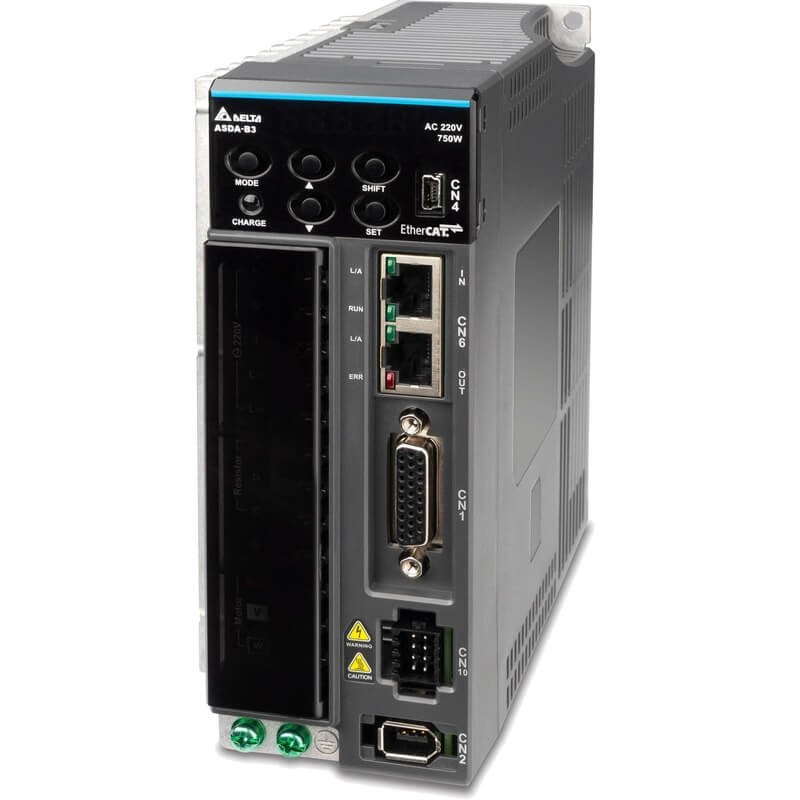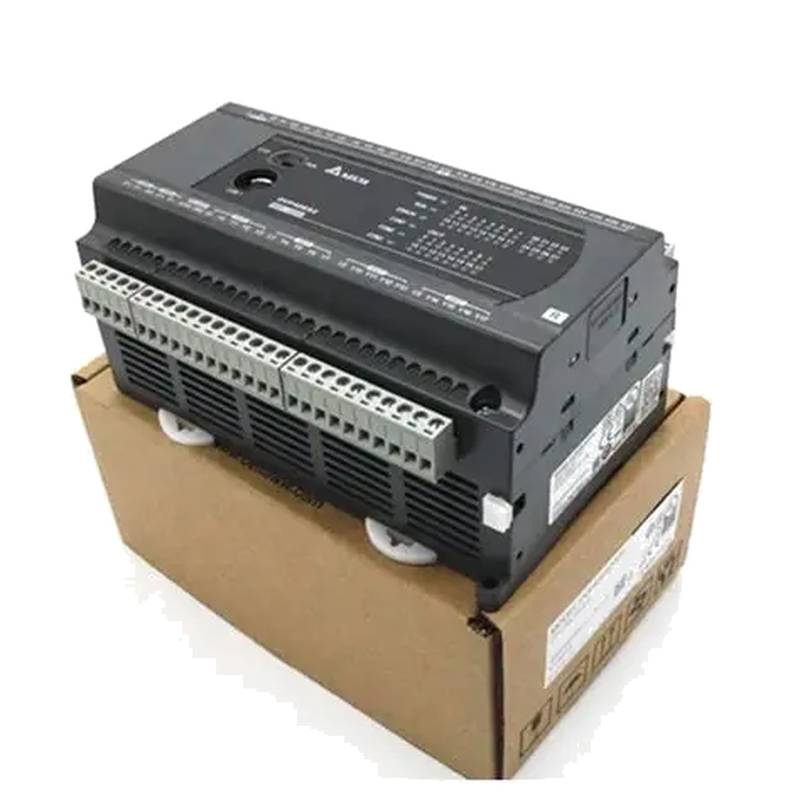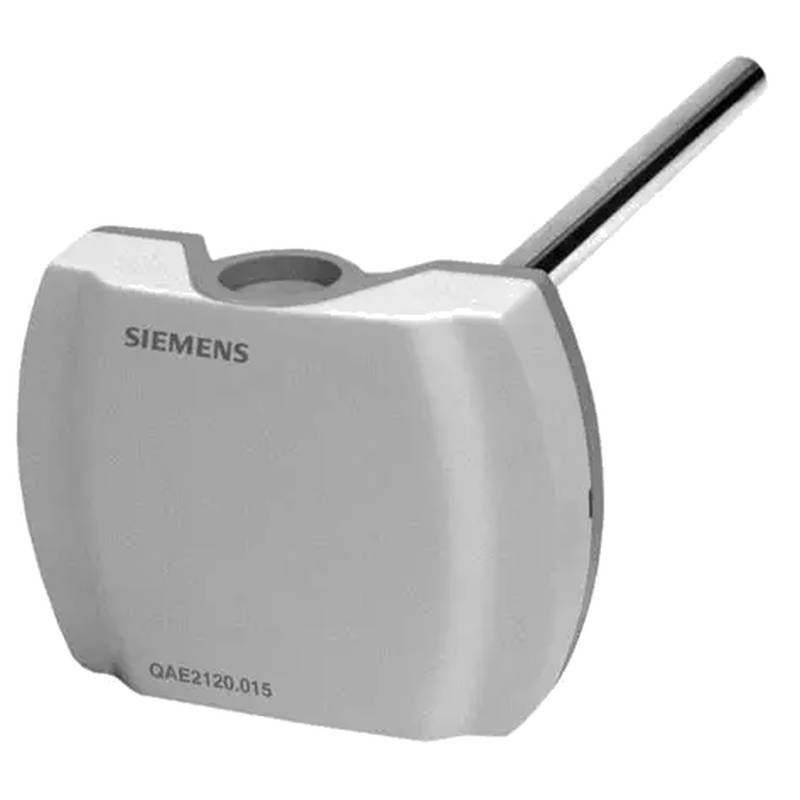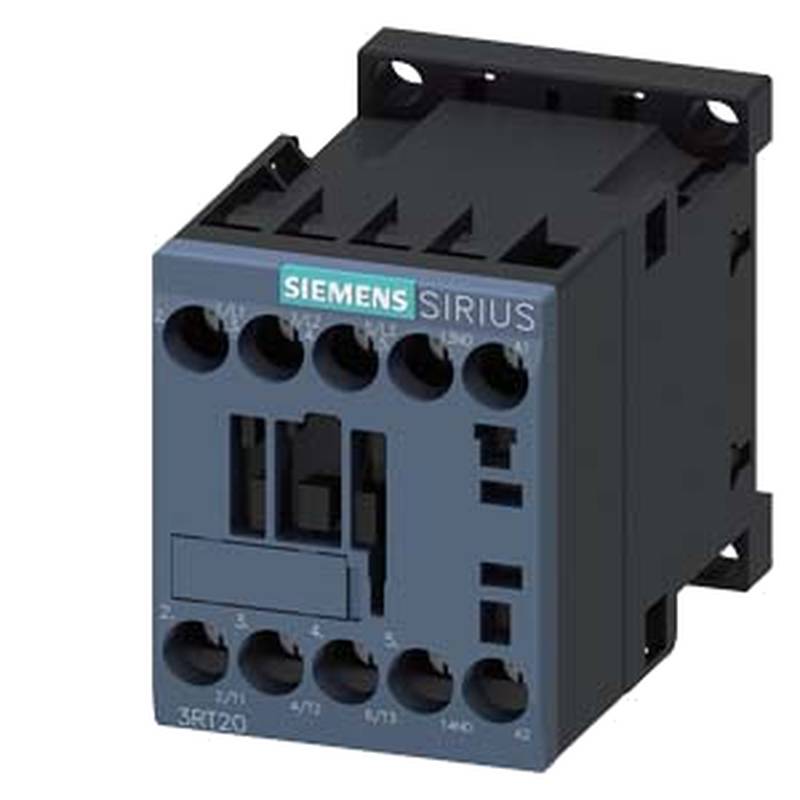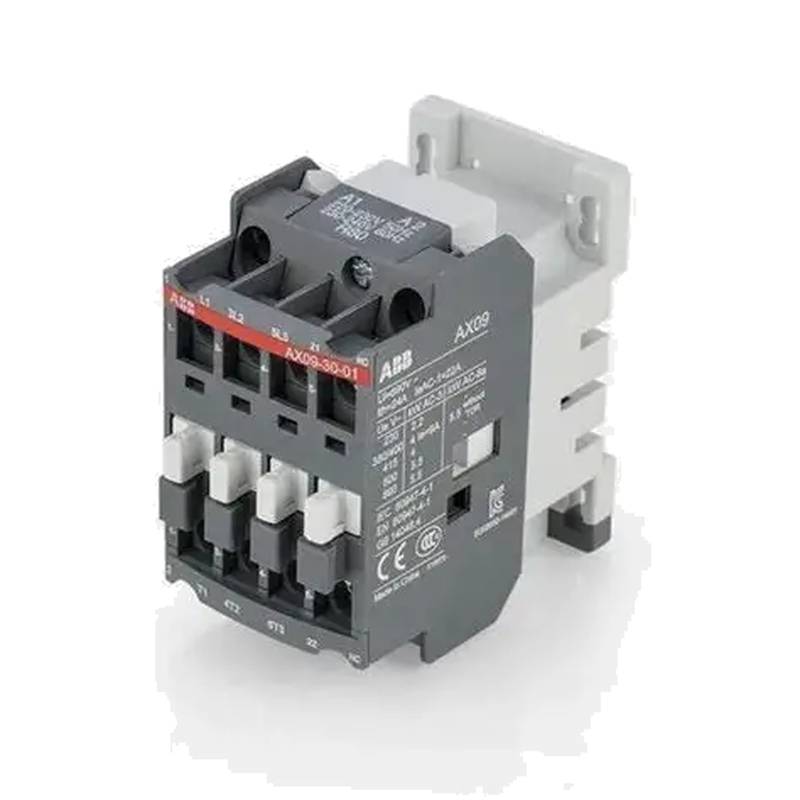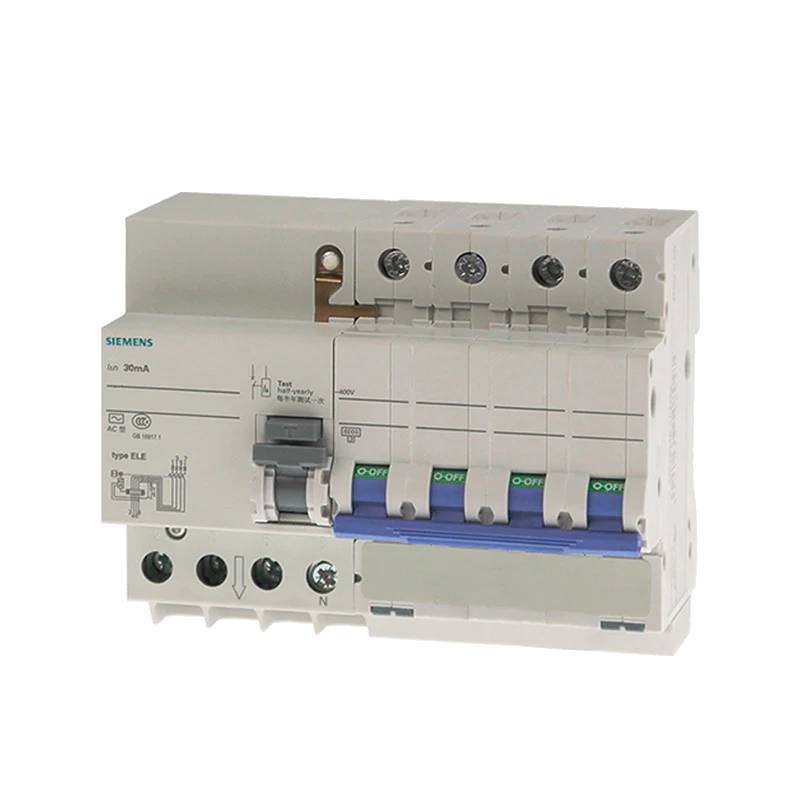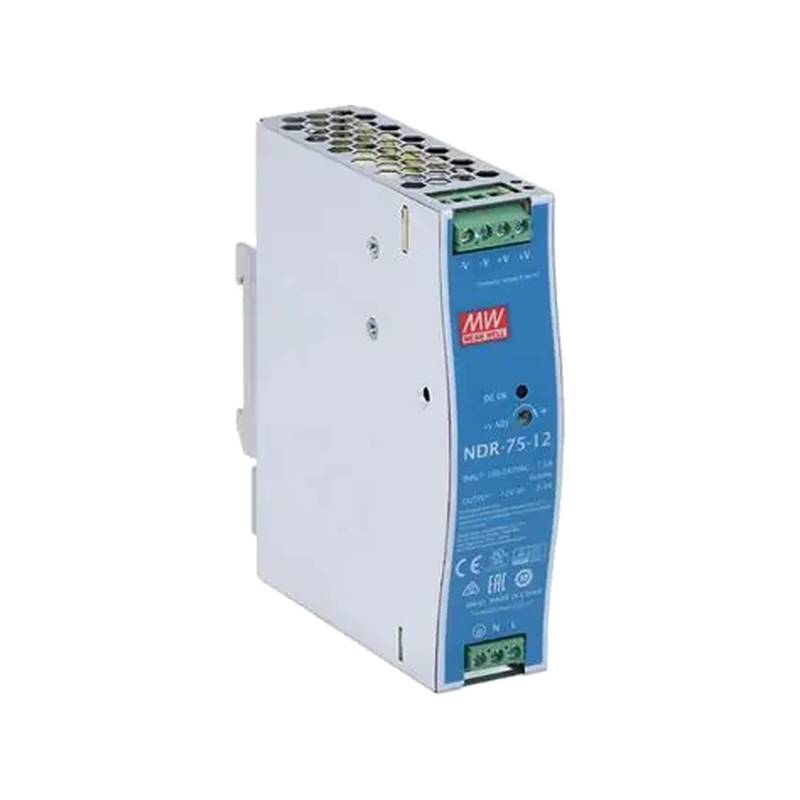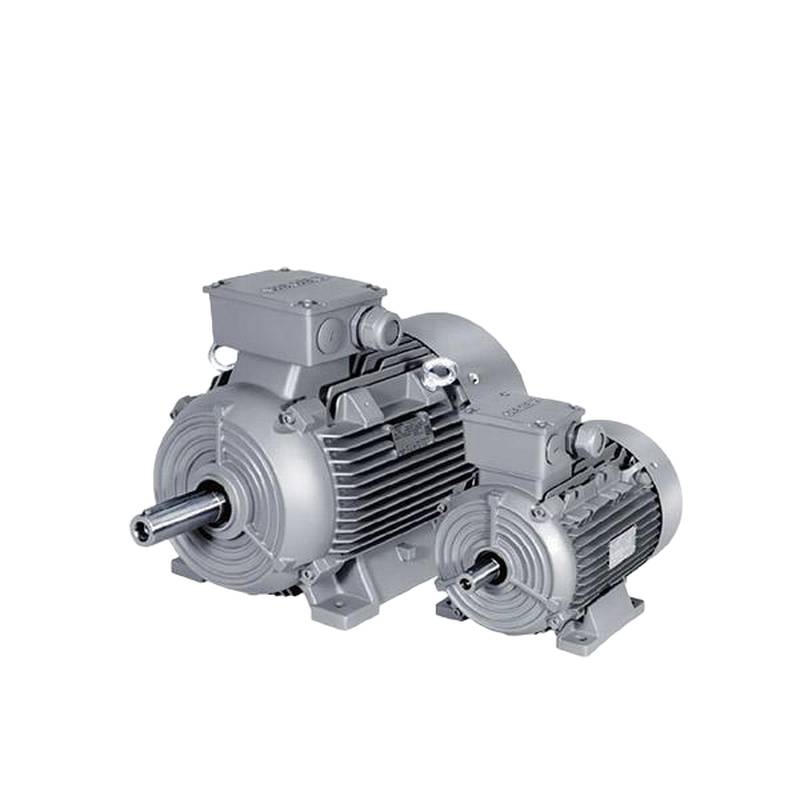
The Delta ASD-B3A-2043-P Intelligent High Inertia Servo Control System represents a significant advancement in motion control technology, engineered for applications demanding precision, speed, and robust performance, particularly where high inertia loads are present. This sophisticated system, part of Delta's third-generation servo solutions, integrates cutting-edge features for superior operational efficiency and user-friendliness. Key advantages include a dramatically reduced settling time of up to 40% compared to previous models, enabling higher production throughput. The ASD-B3A-2043-P boasts a high response bandwidth of 3.1 kHz, an advanced 24-bit encoder for exceptional positioning accuracy, and a maximum motor speed of 6000 rpm with up to 350% of maximum torque. Crucially for high inertia applications, its sophisticated control algorithms and gain adjustment function effectively manage system dynamics and inertia variations, ensuring stable and precise operation. The inclusion of embedded Safe Torque Off (STO) SIL2 functionality enhances operational safety, meeting stringent industrial standards. This system is designed to support a wide array of communication protocols, including EtherCAT, CANopen, and PROFINET, facilitating seamless integration into diverse automation architectures.
Product Specifications
| Feature | Specification |
| :------------------ | :----------------------------------------------------------- |
| Model Number | ASD-B3A-2043-P |
| Product Series | ASDA-B3 |
| Voltage Rating | 200-230V AC (Single/Three-phase for lower kW models) |
| Output Current | 13.4 Arms |
| Power Output | 2 kW |
| Response Bandwidth | 3.1 kHz |
| Encoder Resolution | 24-bit incremental and absolute |
| Max Motor Speed | 6000 rpm |
| Max Torque | 350% of rated torque |
| Control Modes | Position, Speed, Torque, PR Mode, Pulse Train, Analog Voltage, RS-485, CANopen, DMCNET, EtherCAT, PROFINET |
| Safety Feature | Embedded STO (Safe Torque Off) SIL2 |
| Inertia Support | High Inertia, Medium Inertia, Ultra High Inertia |
| Auto-Tuning | Yes |
| Vibration Suppression | Yes |
| Communication | EtherCAT (up to 8 kHz), CANopen, DMCNET, PROFINET |
Core Features & Market Positioning
The Delta ASD-B3A-2043-P is positioned as a high-performance, intelligent servo control system that excels in demanding industrial applications, particularly those involving high inertia loads. Its market differentiation stems from its superior responsiveness, precision, and advanced control capabilities. A key advantage is its ability to significantly reduce settling times by up to 40% compared to previous generations, directly translating to increased productivity and throughput for manufacturers. The integration of a 24-bit encoder ensures unparalleled positioning accuracy, vital for intricate automation tasks. Furthermore, its sophisticated auto-tuning and gain adjustment functions allow the system to dynamically adapt to varying inertia loads, making it ideal for complex machinery where load conditions can change. The inclusion of SIL2-rated Safe Torque Off (STO) as a standard feature underscores Delta's commitment to safety and operational integrity in industrial environments. These attributes collectively position the ASD-B3A-2043-P as a premium solution for industries seeking to optimize performance, enhance reliability, and ensure safety in their automated processes.
Key Application Scenarios
The Delta ASD-B3A-2043-P Intelligent High Inertia Servo Control System is engineered for a broad spectrum of industrial applications that require precise motion control, especially when dealing with substantial inertia. It is extensively deployed in machine tools, where high torque and accurate positioning are paramount for machining operations. The semiconductor industry benefits from its precision for delicate handling and assembly tasks. Industrial robots leverage its responsiveness and accuracy for complex movements and high-speed operations. Furthermore, the system is well-suited for printing and packaging machinery, ensuring consistent speed and accurate registration. Textile manufacturing, warehousing automation, and medical equipment also represent significant application areas where the ASD-B3A-2043-P's robust performance and reliability are critical. Its ability to handle high inertia loads makes it particularly valuable in applications like large gantry systems, robotic arms with heavy payloads, and other machinery requiring stable control of momentum.
Practical System Integration Guidance
Integrating the Delta ASD-B3A-2043-P servo system involves careful consideration of wiring, power supply, and communication protocols to ensure optimal performance and safety. Power input typically requires a 200-230V AC supply, with lower kW models supporting single-phase input. For robust system integration, it is crucial to use appropriate shielded cables for motor power, encoder feedback, and communication signals to prevent electromagnetic interference (EMI). The drive supports various communication protocols, including EtherCAT, CANopen, DMCNET, and PROFINET, which can be configured via specific terminal blocks and connectors (e.g., CN3 for CANopen/RS-485). Delta provides user-friendly software, such as ASDA-Soft, for parameter configuration, auto-tuning, and system analysis, significantly simplifying the commissioning process. When wiring, pay close attention to the main circuit power terminals (R, S, T) and control circuit terminals (L1C, L2C) as detailed in the user manual. The inclusion of DC Bus Sharing capability can further simplify multi-axis system wiring and reduce installation complexity.
Operation and Risk Mitigation
Safe and efficient operation of the Delta ASD-B3A-2043-P is paramount, with Delta emphasizing built-in safety features and clear operational guidelines. The system features an embedded Safe Torque Off (STO) function with SIL2 certification, which provides a reliable means to disconnect motor power in emergency situations without requiring external safety relays for many applications. Proper installation within a shielded control cabinet is recommended to minimize electrical noise and ensure precise operation. Users must consult the comprehensive ASDA-B3 Series User Manual for detailed safety precautions, especially concerning motor handling and environmental conditions. Troubleshooting is aided by a clear alarm display (AL nnn format) and a detailed alarm list categorized into General, Motion Control, STO, and Communication types. Common troubleshooting steps include verifying encoder signal integrity, checking parameter settings, and ensuring correct wiring configurations. For persistent issues, contacting Delta technical support or a local distributor is advised.
Scalability & Long-Term Value
The Delta ASD-B3A-2043-P servo system is designed with scalability and long-term value in mind, offering compatibility and future-proofing for industrial automation. Its compatibility with previous Delta servo motor series (B3, B2, A3, and A2) allows for phased upgrades and integration into existing systems, providing a clear upgrade path. The support for multiple high-speed communication protocols, including EtherCAT, CANopen, and PROFINET, ensures it can seamlessly integrate with a wide range of PLCs, HMIs, and other industrial control systems, aligning with Industry 4.0 and IIoT initiatives. The system's advanced control algorithms and precise feedback mechanisms contribute to increased machine lifespan and reduced maintenance requirements due to optimized motion profiles and reduced mechanical stress. Furthermore, Delta's commitment to continuous development and comprehensive support, including readily available documentation and software updates, ensures the long-term viability and performance of the ASD-B3A-2043-P within evolving industrial landscapes.
Frequently Asked Questions (FAQs)
1. What are the primary advantages of the Delta ASD-B3A-2043-P for high inertia applications?
The ASD-B3A-2043-P offers superior performance in high inertia scenarios due to advanced control algorithms that effectively manage and stabilize system dynamics. Its high torque output and precise feedback mechanisms ensure robust control over heavy or momentum-rich loads. This enables smoother acceleration and deceleration, preventing oscillations and maintaining positional accuracy.
The system features sophisticated auto-tuning and gain adjustment functions, allowing it to dynamically adapt to varying inertia levels. This adaptability is crucial for applications where load conditions change, ensuring consistent and reliable operation. The drive's high rigidity and stiffness also contribute to maintaining control even under demanding inertia conditions.
Its robust construction and advanced thermal management contribute to sustained performance during prolonged operation with high inertia. This reliability minimizes downtime and ensures consistent output quality, making it ideal for continuous industrial processes.
2. How does the Delta ASD-B3A-2043-P improve settling time and productivity?
The ASDA-B3 series, including the ASD-B3A-2043-P, achieves up to a 40% reduction in settling time compared to previous Delta models. This acceleration in reaching a stable position allows machinery to cycle faster. Increased machine throughput directly translates to higher overall production efficiency.
This improved settling time is a result of its high response bandwidth (3.1 kHz) and advanced control algorithms. These enable the servo system to react more quickly to commands and correct deviations with greater speed. The system's ability to precisely manage torque and speed profiles optimizes motion paths.
By minimizing the time spent waiting for the system to stabilize, manufacturers can increase the number of operations performed per unit of time. This enhanced productivity boosts output value and strengthens a company's competitive edge in fast-paced markets.
3. What communication protocols does the Delta ASD-B3A-2043-P support for system integration?
The ASD-B3A-2043-P supports a comprehensive suite of industrial communication protocols. This includes high-speed options like EtherCAT, which can operate at up to 8 kHz, significantly reducing wiring complexity in multi-axis systems. It also supports CANopen, DMCNET, and PROFINET.
This wide range of protocol support ensures interoperability with diverse automation equipment. It allows seamless integration into existing control architectures, whether they utilize traditional fieldbuses or modern industrial Ethernet networks. This flexibility is key for building sophisticated automated systems.
By supporting these standard protocols, the Delta ASD-B3A-2043-P facilitates easy integration into Industry 4.0 and IIoT environments. It enables data exchange and advanced control strategies, supporting the development of smart factories and connected manufacturing operations.
4. What are the key safety features of the Delta ASD-B3A-2043-P?
A primary safety feature is the embedded Safe Torque Off (STO) function, rated to SIL2 (Safety Integrity Level 2). This function provides a reliable way to remove power to the motor in hazardous situations, preventing unexpected movement. It can often eliminate the need for external safety relays, simplifying system design.
The STO feature is integrated directly into the drive's hardware, ensuring a high level of safety performance (PL-D). This enhances worker safety by providing a rapid and dependable mechanism to halt machine motion when safety conditions are compromised. It meets rigorous international safety standards for industrial machinery.
Beyond STO, the drive's overall design emphasizes reliability and stable operation. Features like precise position control and vibration suppression contribute to predictable machine behavior, reducing the risk of unexpected movements or failures that could lead to hazardous conditions.
5. How does the 24-bit encoder contribute to the performance of the ASD-B3A-2043-P?
The 24-bit encoder provides an extremely high resolution for position feedback. This translates to highly accurate and precise movements, essential for applications requiring sub-micron precision. It allows the servo system to detect and correct even minute deviations from the desired path.
This high resolution enables superior closed-loop control, particularly at low speeds or during intricate positioning tasks. It ensures smooth motor operation and reduces position errors, contributing to better product quality and process repeatability. The encoder data is retained even when drive power is off.
The increased resolution also enhances the system's ability to perform complex motion profiles with greater fidelity. It allows for finer control over acceleration, deceleration, and speed, which is critical for dynamic applications and minimizing mechanical stress.
6. What types of applications are best suited for the ASD-B3A-2043-P?
This servo drive is ideally suited for applications demanding high precision and dynamic performance, especially those involving heavy or high inertia loads. This includes advanced machine tools requiring accurate cutting paths and rapid tool changes. It's also excellent for industrial robots performing complex assembly or pick-and-place operations with significant payloads.
Industries such as semiconductor manufacturing, where microscopic precision is critical, benefit greatly from its high-resolution feedback. Printing and packaging machinery also rely on its consistent speed and precise registration capabilities for high-volume production.
Other suitable applications include textile machinery, high-speed sorting and handling systems in warehousing, and advanced medical equipment requiring very fine motion control. Its versatility covers a broad range of automation challenges where robust and accurate motion control is essential.
7. Can the ASD-B3A-2043-P be integrated with existing Delta servo motors?
Yes, the ASDA-B3 series drives, including the ASD-B3A-2043-P, offer compatibility with previous Delta servo motor generations. This includes compatibility with B3, B2, A3, and A2 motor series. This broad compatibility facilitates upgrades and integration into existing Delta servo systems.
This backward compatibility is a significant advantage for users looking to enhance their current automation setups. It allows for a gradual transition to newer technology, reducing the need for a complete overhaul of motors and associated hardware. Existing motor investments can often be leveraged.
When upgrading, it is always recommended to consult Delta's documentation to ensure optimal pairing of motor and drive for the specific application requirements. This ensures that the full performance potential of both components is realized, particularly when moving to a high inertia solution.
8. How does the auto-tuning function simplify setup and commissioning?
The auto-tuning function significantly simplifies the setup and commissioning process for the ASD-B3A-2043-P. It allows users to easily achieve optimal servo system performance without requiring complex manual adjustments or extensive tuning expertise. The drive automatically analyzes the connected motor and load characteristics.
By automatically detecting inertia and other system parameters, the drive configures its internal control loops for maximum efficiency and stability. This process minimizes the time typically spent on manual gain tuning, reducing engineering effort and speeding up machine deployment.
This user-friendly feature makes the system accessible to a wider range of users, including those with less specialized servo tuning experience. It ensures that even in applications with varying loads, the servo system operates at its peak performance consistently.
9. What troubleshooting resources are available for the ASD-B3A-2043-P?
Delta provides comprehensive troubleshooting resources for the ASD-B3A-2043-P. The ASDA-B3 Series User Manual includes a detailed alarm list, categorizing errors into General, Motion Control, STO, and Communication types. Each alarm code (AL nnn) is explained with potential causes and corrective actions.
The drive features a diagnostic display that shows alarm codes, aiding in rapid identification of issues. For persistent problems, users can consult their local Delta distributor or contact Delta technical services for expert assistance. Documentation often includes wiring diagrams and parameter descriptions to help diagnose setup errors.
Software tools like ASDA-Soft may also offer diagnostic features or logging capabilities that can help track system behavior and identify the root cause of malfunctions. Following the recommended procedures in the manual is crucial for effective troubleshooting.
10. How does the Delta ASD-B3A-2043-P contribute to IIoT and Industry 4.0 initiatives?
The ASD-B3A-2043-P supports key communication protocols like EtherCAT and PROFINET, which are foundational for Industry 4.0 integration. These protocols enable seamless data exchange with PLCs, SCADA systems, and IIoT platforms. This connectivity allows for remote monitoring, diagnostics, and predictive maintenance.
Its precise motion control capabilities enhance the efficiency and quality of automated processes, aligning with the goals of smart manufacturing. The ability to collect and analyze operational data from the drive supports optimization efforts and the development of data-driven decision-making.
By offering features like STO and high precision, the drive ensures safe and reliable operation, critical for interconnected industrial systems. Its compatibility with modern network architectures allows it to be a central component in the evolving landscape of connected industrial automation.














